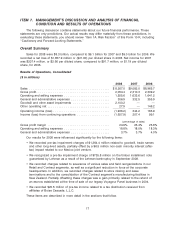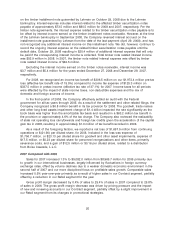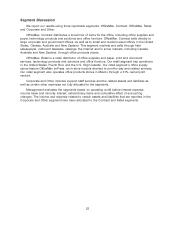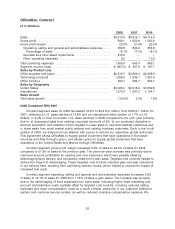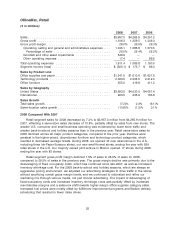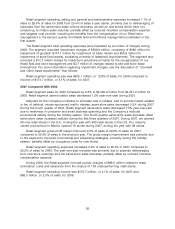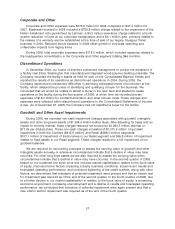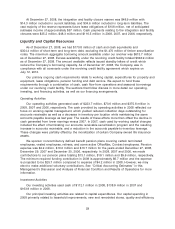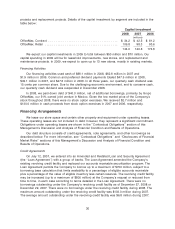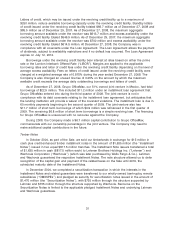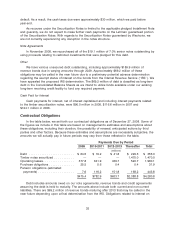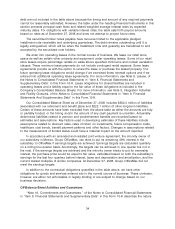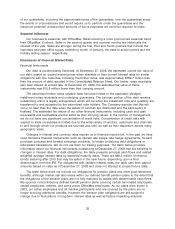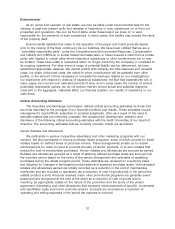OfficeMax 2008 Annual Report Download - page 31
Download and view the complete annual report
Please find page 31 of the 2008 OfficeMax annual report below. You can navigate through the pages in the report by either clicking on the pages listed below, or by using the keyword search tool below to find specific information within the annual report.Corporate and Other
Corporate and Other expenses were $773.6 million for 2008 compared to $37.4 million for
2007. Expenses recorded in 2008 included a $735.8 million charge related to the impairment of the
timber installment note guaranteed by Lehman, a $4.3 million severance charge related to a fourth
quarter reduction in force at our corporate headquarters and a $3.1 million gain, primarily related to
the release of a warranty escrow established at the time of sale of our legacy Voyageur Panel
business in 2004. Reduced bonus expense in 2008 offset growth in corporate spending and
unfavorable impacts from legacy items.
During 2006, total corporate expenses were $118.0 million, which included expenses related to
the headquarters consolidation in the Corporate and Other segment totaling $46.4 million.
Discontinued Operations
In December 2004, our board of directors authorized management to pursue the divestiture of
a facility near Elma, Washington that manufactured integrated wood-polymer building materials. The
Company recorded the facility’s assets as held for sale on the Consolidated Balance Sheets and
reported the results of its operations as discontinued operations in 2004. During 2005, the
Company experienced unexpected difficulties in achieving anticipated levels of production at the
facility, which delayed the process of identifying and qualifying a buyer for the business. We
concluded that we would be unable to attract a buyer in the near term and elected to cease
operations at the facility during the first quarter of 2006, at which time we recorded pre-tax
expenses of $18.0 million for contract termination and other closure costs. These charges and
expenses were reflected within discontinued operations in the Consolidated Statements of Income
(Loss). As of December 27, 2008, the Company has not identified a buyer for the facility.
Goodwill and Other Asset Impairments
During 2008, we recorded non-cash impairment charges associated with goodwill, intangible
assets and other long-lived assets of $1,364.4 million before taxes. After adjusting for taxes and an
impact to minority interest, these charges reduced net income by $1,294.7 million after-tax or
$17.05 per diluted share. These non-cash charges consisted of $1,201.5 million of goodwill
impairment in both the Contract ($815.5 million) and Retail ($386.0 million) segments;
$107.1 million of impairment of trade names in our Retail segment and $55.8 million of impairment
related to fixed assets in our Retail segment. These charges resulted in a full impairment of our
goodwill balances.
We are required for accounting purposes to assess the carrying value of goodwill and other
intangible assets annually or whenever circumstances indicate that a decline in value may have
occurred. For other long-lived assets we are also required to assess the carrying value when
circumstances indicate that a decline in value may have occurred. In the second quarter of 2008,
based on our sustained low stock price and reduced market capitalization relative to the book value
of equity, macroeconomic factors impacting industry business conditions, actual recent results and
forecasted operating performance, and continued tightening of the credit markets, along with other
factors, we determined that indicators of potential impairment were present and that an interim test
for impairment was required as of the end of the second quarter. In the fourth quarter of 2008, due
to a further decline in our market capitalization in relation to the book value of equity, a worsening
economic environment, increasing unemployment and a decline in results and forecasted operating
performance, we concluded that indicators of potential impairment were again present and that a
new interim test for impairment was required as of the end of the fourth quarter.
27


